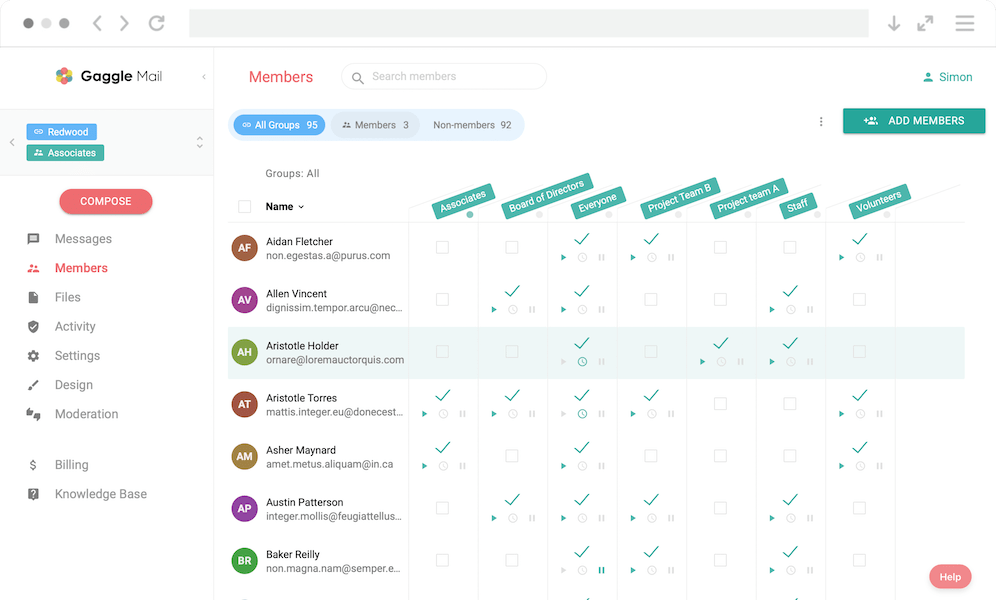The Definitive Guide
What is a Listserv?
A Listserv is a way of communicating with a group of people over email. You send a message to the group address, and it gets sent to everyone in the group.
Learn about the history, evolution, and enduring appeal of Listservs, making them a staple of electronic communication for almost 40 years.
Introduction
In the ever-evolving landscape of digital communication, the term "Listserv" stands out as a pioneering technology that has significantly influenced how we connect and share information online.
Originating in the early days of internet communication, Listserv has provided a platform for group email discussions, allowing users to send a single email to a mailing list, which then distributes the message to all members of the list. This system has been instrumental in fostering communities, facilitating academic discourse, and enabling efficient communication for organizations and groups worldwide. Despite the advent of more modern communication tools, Listserv's importance in digital communication remains undiminished, serving as a testament to its reliability and effectiveness.
Understanding Listserv
Definition and Origin
Listserv, a portmanteau of "List Server," is an automated mailing list management system that was developed in 1986 by Eric Thomas. It was one of the first email list management systems that allowed users to easily subscribe or unsubscribe from email lists without the need for manual intervention by a list administrator. The system's ability to manage subscriptions and distribute messages to large groups of people made it an instant hit among academic institutions, organizations, and interest groups seeking a reliable way to disseminate information and foster discussions.
How Listserv Works
At its core, Listserv operates on a subscription-based model where individuals can join or leave mailing lists at their discretion. When a member sends an email to the list's email address, the Listserv software automatically forwards the message to all other subscribers, ensuring that everyone in the group receives the communication. This process simplifies group discussions, as it eliminates the need to send individual emails to each member, thereby streamlining communication and enhancing productivity.
Comparison with Modern Communication Tools
While Listserv remains a powerful tool for group communication, it's essential to recognize its place alongside modern digital communication platforms like social media, instant messaging apps, and collaborative workspaces. Unlike these newer platforms that offer real-time interaction, multimedia sharing, and more integrated user experiences, Listserv focuses on simplicity and efficiency in email-based communication. Its continued use, particularly in academic and professional settings, underscores its effectiveness in scenarios where straightforward, email-centric communication is preferred or required.
The Evolution of Listserv
The story of Listserv's evolution is a fascinating journey through the history of digital communication, reflecting broader technological advancements and changing user needs over time.
Historical Background
Listserv's inception in 1986 marked a significant milestone in the development of electronic mailing lists. Initially designed to facilitate academic and research communications, its utility quickly spread to various sectors. The early versions of Listserv ran on mainframe computers, a testament to its origins in an era when personal computing was just beginning to gain traction. As the internet expanded, so did Listserv, evolving to meet the demands of a growing and diversifying user base.
Key Developments Over the Years
One of the most significant developments in Listserv's history was its transition from a proprietary software model to one that embraced the burgeoning open-source movement. This shift allowed for greater customization, integration with other technologies, and adaptation to the changing digital landscape. Over the years, Listserv introduced features such as web-based archives, enhanced security measures, and sophisticated subscription management tools, all while maintaining the simplicity and reliability that users valued.
The advent of HTML emails and multimedia content brought another layer of complexity and capability to Listserv. Users could now share richer content, making Listserv an even more powerful tool for communication and collaboration. Despite these advancements, Listserv maintained its core principle of efficient email distribution, ensuring that it remained accessible and valuable to all users, regardless of their technical expertise.
Current Relevance in the Age of Social Media
In an era dominated by social media and instant messaging, one might wonder about the relevance of a technology like Listserv. However, Listserv has maintained a loyal user base, particularly among academic institutions, research groups, and professional organizations. Its ability to facilitate focused, topic-specific discussions without the distractions and noise common to social media platforms makes it an invaluable tool for many communities. Moreover, Listserv's emphasis on privacy and control over one's data is increasingly appealing in an age where concerns about data security and privacy are paramount.
Key Features of Listserv
Listserv offers a range of features that contribute to its enduring popularity and utility. Here, we delve into some of the key functionalities that make Listserv a preferred choice for many organizations and groups.
Subscription Management
One of Listserv's core strengths is its simple subscription management system. Users can easily subscribe or unsubscribe from lists with simple email commands or through web interfaces, giving them complete control over their participation. List administrators can also manage subscriptions, ensuring that the list remains relevant and valuable to its members.
Message Distribution Mechanisms
Listserv's efficient message distribution system ensures that emails are promptly delivered to all list members, regardless of the list's size. This reliability is crucial for time-sensitive communications and for maintaining active, engaged communities. The system also supports digest options, where users can receive a daily or weekly summary of emails, reducing inbox clutter while keeping members informed.
Moderation and Administrative Features
Listserv provides robust moderation tools that allow list administrators to review and approve messages before distribution, helping to maintain the quality and relevance of discussions. These features are particularly useful for large or public lists, where the potential for spam or off-topic messages is higher.
Integration with Other Platforms
Understanding the diverse ecosystem of digital tools used by organizations and individuals, Listserv has evolved to offer integration options with other platforms. This includes compatibility with content management systems, integration with social media for broader message distribution, and APIs that allow for custom integrations, enhancing Listserv's flexibility and utility in a variety of contexts.
Benefits of Using Listserv
Listserv's enduring presence in the digital communication landscape can be attributed to its unique set of benefits that cater to diverse groups and organizations. Here we highlight the key advantages that make Listserv a valuable tool for effective communication.
Efficient Group Communication
Listserv simplifies the process of reaching out to large groups, making it an efficient tool for disseminating information and fostering discussions. By allowing users to send a single email to a central address that then redistributes the message to all list members, Listserv eliminates the need for complex BCC fields or the risk of omitting recipients, ensuring that communications are streamlined and inclusive.
Scalability for Large Audiences
One of Listserv's most significant strengths is its ability to manage mailing lists with thousands of subscribers without compromising performance. This scalability makes it an ideal solution for large organizations, academic institutions, and special interest groups that need to communicate with extensive communities.
Customization and Control for Administrators
List administrators have access to a wide range of tools and settings that allow them to customize how their lists operate. From setting subscription policies and moderation levels to managing archives and tailoring notification settings, Listserv provides a level of control that ensures the list operates in alignment with the group's needs and preferences.
Challenges and Considerations
While Listserv offers numerous benefits, it's essential to acknowledge the challenges and considerations that come with its use. Addressing these can help maximize the effectiveness of Listserv and ensure a positive experience for both administrators and subscribers.
Managing Spam and Security
As with any email-based system, Listserv lists can be susceptible to spam and security threats. Effective management requires vigilance and the use of built-in security features, such as subscription confirmation and message moderation, to protect the integrity of discussions and safeguard member privacy.
User Engagement and Interaction
Maintaining active and engaged communities on Listserv can be challenging, especially in an era dominated by more interactive social media platforms. Encouraging meaningful discussions and fostering a sense of community among list members are vital for sustaining interest and participation.
Technical Maintenance and Support
Running a Listserv requires a certain level of technical know-how, particularly for customization, integration, and troubleshooting. Ensuring that there is adequate support and resources available for administrators is crucial for the smooth operation of Listserv lists.
Listserv in Different Contexts
Listserv's versatility allows it to serve a wide range of purposes across various sectors. Here, we explore its application in different contexts, highlighting its adaptability and effectiveness.
Academic and Research Communities
In academic and research settings, Listserv remains a preferred tool for sharing knowledge, discussing research findings, and collaborating on projects. It provides a focused environment for scholarly communication, free from the distractions of social media.
Non-profit Organizations and Advocacy Groups
For non-profit organizations and advocacy groups, Listserv offers an efficient way to mobilize supporters, share updates, and coordinate activities. Its ability to reach large audiences quickly and reliably makes it an essential tool for driving social change.
Business and Professional Networking
Listserv also finds its place in business and professional networking, where it facilitates industry discussions, company-wide announcements, and professional development opportunities. Its straightforward, email-based approach ensures that important information is communicated effectively, keeping professionals connected and informed.
Conclusion
Listserv has played a pivotal role in shaping digital communication, offering a reliable, efficient, and scalable solution for email-based group discussions. Despite the rise of alternative communication platforms, its unique benefits, such as effective group communication, scalability, and customization options, continue to make it relevant and valuable in various contexts. As we look to the future, the adaptability of Listserv and its ability to integrate with other digital tools suggest that it will remain an important component of the digital communication toolkit.
Frequently asked questions
Have a different question and can’t find the answer you’re looking for? Reach out to our support team by sending us an email and we’ll get back to you as soon as we can.
- How do I join a Listserv list?
- Typically, you can join by sending an email to the list's subscription address or by signing up through a web interface provided by the list administrator.
- Can anyone start a Listserv list?
- Yes, but starting a Listserv list usually requires access to Listserv software, which might be provided by your institution or through a Listserv hosting service.
- How does Listserv handle privacy and data security?
- Listserv includes features designed to protect user privacy and data security, such as encrypted email options, secure subscription processes, and privacy controls for list archives.
Ready to dive in? Get started for free today.
Completely free for groups of up to 1,000 members. All paid plans have 30-day free trial, no credit card required.
Get Started
